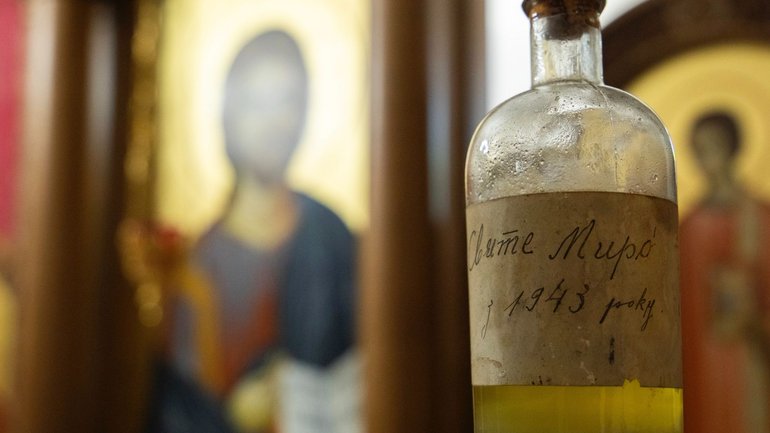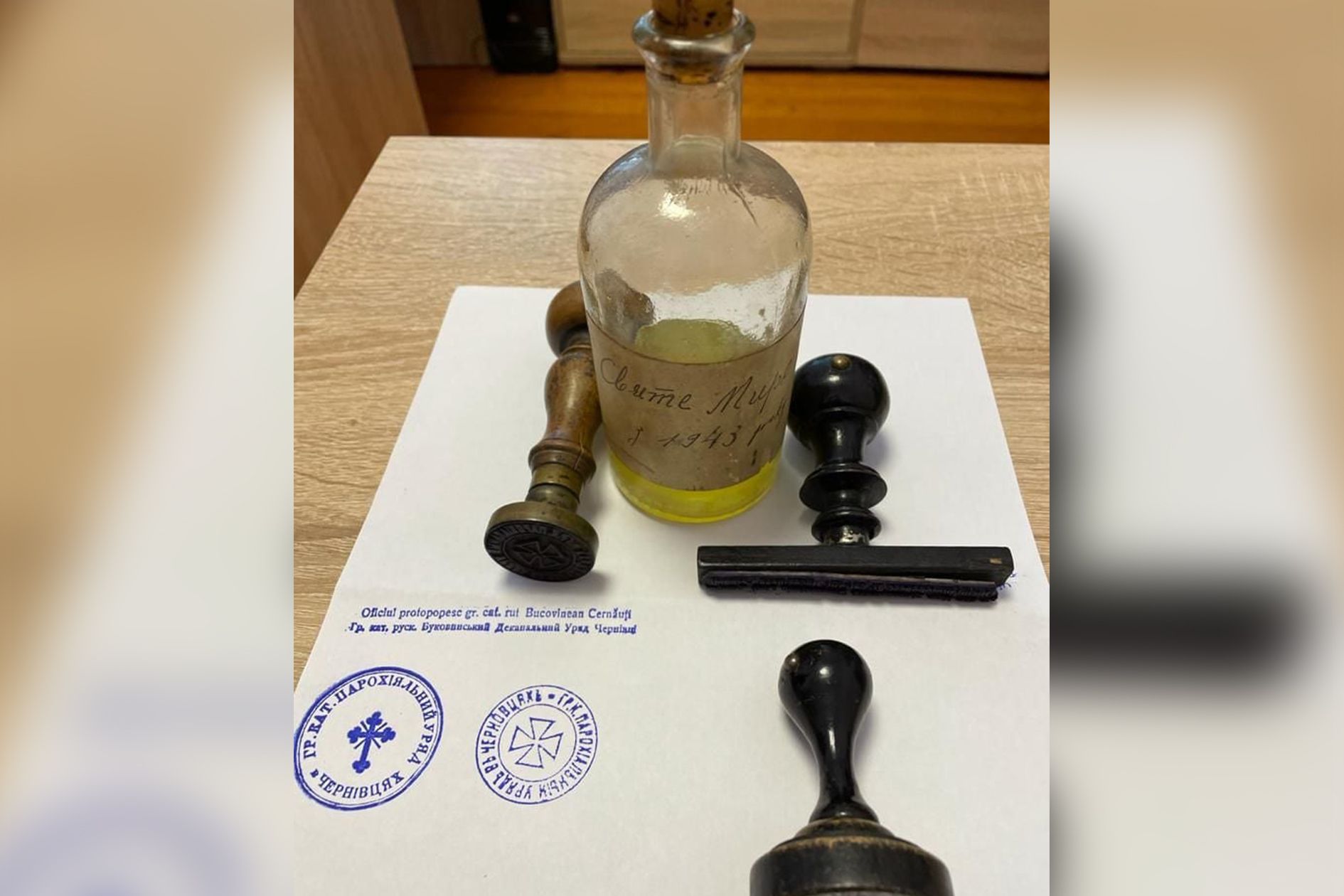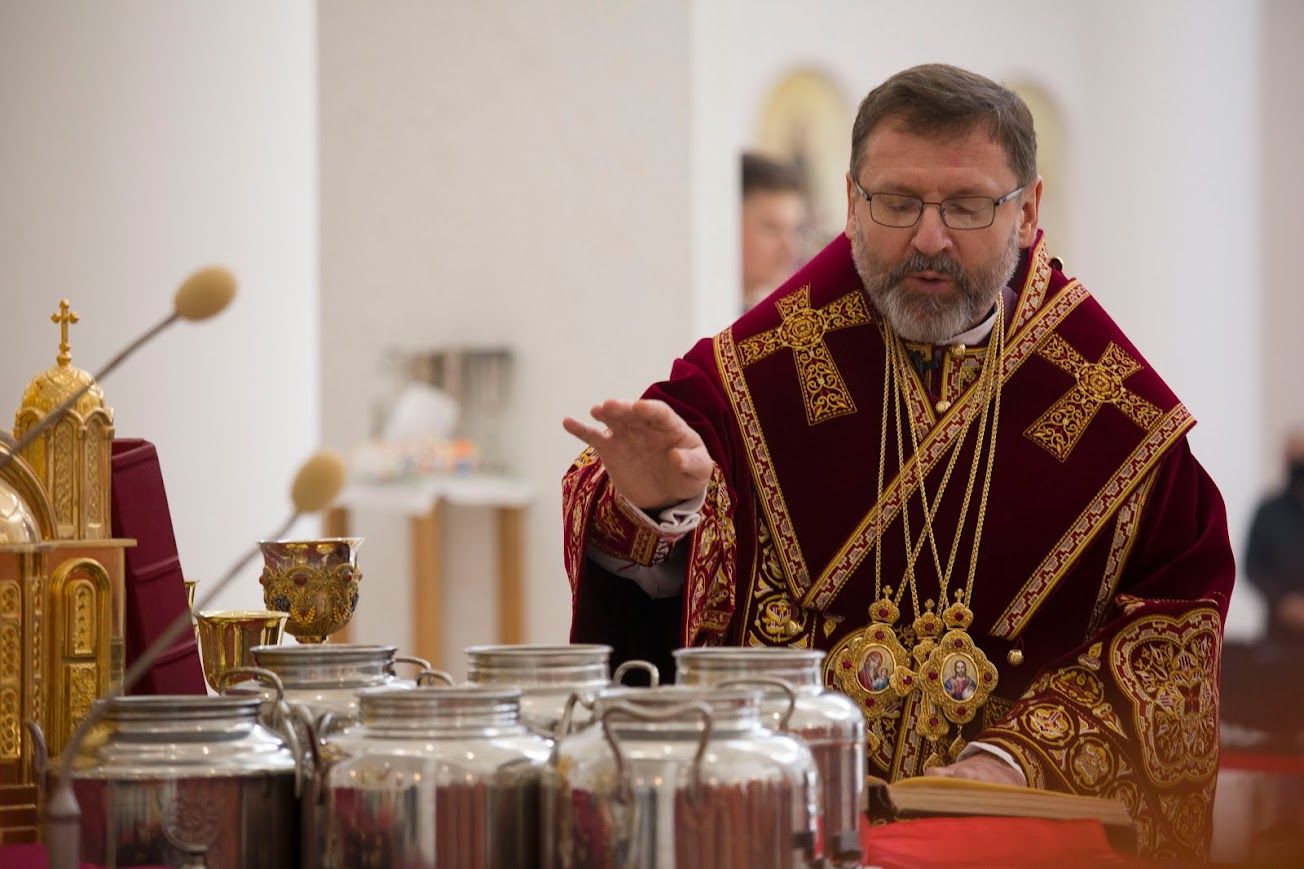From War to War: On Maundy Thursday, the head of the UGCC to combine new chrism with WWII-time anointing

"The grace of the Holy Spirit, which strengthened our ancestors during World War II, is passed down to us as a legacy and will strengthen us in the Russian-Ukrainian war today," the UGCC Information Department reports.
The story of the discovery of myrrh in 1943 was told by the auxiliary bishop of the Kolomyia Diocese, Bishop Petro Holiney. According to him, in 1990, when the community of the UGCC in Chernivtsi returned the cathedral church, Father Mykhailo Kosylo served there.
"In the cathedral church, there was a throne made of white tiles in the form of a stove. In the middle of the throne, there was a place to light a fire. It was both a throne and a stove that heated the sanctuary, even during the time of Romania. When our community returned, people saw that the throne was damaged. The stove fitter dismantled the part that served as a stove. There, he found a hiding place where old seals of the community from the Austrian and Romanian periods, a priest's silver pectoral cross, and the myrrh of 1943 were kept," Bishop Petro said.

"It is likely that the myrrh came from Stanislaviv because our priests did not want to take it from Romanian Greek Catholic bishops but asked for it from Galicia. I cannot definitively confirm this," the hierarch noted, adding, "If my assumption is true, then it was consecrated by Hryhoriy Khomyshyn. As far as I know, the priests corresponded with him and always took myrrh from bishops from Galicia. The vial of myrrh was kept in the Museum of the Underground Spiritual Seminary in Dora. In the summer of 2021, it was transferred to Chernivtsi. This hiding place survived the Soviet occupation. In the 1950s, the church was completely closed. It housed a toy warehouse from the store. No one suspected it."
On August 10, 2021, Bishop Petro Holiney handed the myrrh over to Bishop Josaphat Moschych.

During the Permanent Synod, held from December 12 to 15, 2023, in Chernivtsi, Bishop Josaphat Moschych told His Beatitude Sviatoslav about the myrrh found in the throne of the cathedral.
"During the Permanent Synod, we talked about the context of war, about constantly being in wartime. This is the myrrh of the war period. It testifies that the Church during the Second World War was active, cared for the faithful, fulfilled its mission—continued to be with its people," said the Bishop of Chernivtsi.
"His Beatitude Sviatoslav then said that it would be good this year on Maundy Thursday to pour this myrrh found in Chernivtsi. I agreed to pass it on and recently did so," added Bishop Josaphat.
In the Catechism of the UGCC, "Christ Is Our Easter," it is noted that the rite of anointing with myrrh is performed immediately after baptism because where there is life, there is breath: "Holy Chrism—a fragrant mixture of oil and various aromatic substances—is a symbol of the richness and diversity of spiritual gifts bestowed by the Holy Spirit on the newly born in Christ."
Saint Cyril of Jerusalem wrote that "Holy Chrism is not ordinary myrrh after consecration—it has become a gift of Christ, and through the presence of the Holy Spirit in it, it has the power of God."
The chrism touches a person only once in a lifetime, the UGCC explains, adding that it is important not to confuse chrism with oil, with which the priest anoints the faithful throughout the year on holidays or during the twelve feasts.
The priest, while anointing with chrism certain parts of the body of the newly baptized person for consecration, says, "The seal of the gift of the Holy Spirit." This symbolizes the grace of the Holy Spirit descending upon the person. The Holy Chrism is also used during the consecration of a newly built church—it is used to anoint the throne and the four sides of the church itself.
According to His Beatitude Sviatoslav, "The Sacrament of Chrismation is the granting of the gift of Pentecost to the newly baptized, the grace of the Holy Spirit. This is the moment when the Holy Spirit fills the new person who joins the cohort of Christ's disciples. The Holy Spirit descends upon this person as He did upon the apostles gathered in the upper room on the 50th day after the Resurrection of Christ. Chrismation also has its sign, symbol, like the Sacrament itself, which is a visible sign of invisible grace, its sacramental secret words, with which it is conferred, and the gesture by which this ministry is performed."
Chrism is a special fragrant oil consecrated by the Primate of the local Church only once a year—on Maundy Thursday, and this gesture testifies to the unity of the entire Church. Holy Chrism, as a mixture of special noble fragrances in the history of God's people, was a symbol and sign of the anointing of kings, priests, and prophets. Anointing with this holy and great myrrh makes the baptized person a participant or, rather, a communicant of the triple mission of Jesus Christ Himself, who was simultaneously a priest, king, and prophet.
The head of the UGCC explained that through the Sacrament of Chrismation, the person who enters the Church of Christ becomes part of the divinely chosen people of the New Testament, that royal people; becomes a communicant of its mission—to proclaim God's word and be a witness to God's action in modern life; becomes a participant in the so-called common priesthood, which allows him to offer personal spiritual sacrifices on the throne of our Divine Service. So, a person, anointed with the Holy Chrism, becomes a participant in the mission of the Church of Christ, a great task, and begins to breathe the Holy Spirit.

This year, on Maundy Thursday, the Head of the UGCC will pour myrrh and consecrate it as a symbol of the steadfastness and resilience of the Ukrainian Greek Catholic Church along with the Ukrainian people during various military adversities that have befallen Ukraine.









